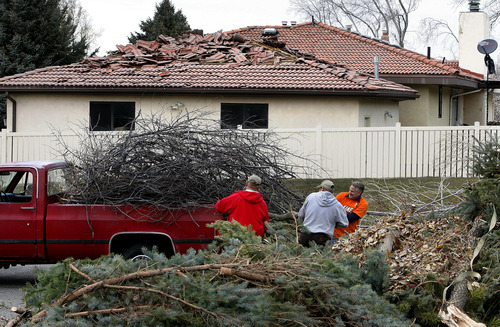This is an archived article that was published on sltrib.com in 2013, and information in the article may be outdated. It is provided only for personal research purposes and may not be reprinted.
You've got a 72-hour supply of food and water, a first-aid kit in the car and a plan to take care of your family and pets when the "big one" hits Utah. But are you financially prepared for disaster?
As hundreds of thousands of Utahns take part in the Great Utah ShakeOut statewide earthquake drill Wednesday morning, the focus is on "drop, cover and hold on" survival skills, food storage and shelter after a massive earthquake. But many people don't realize there's a money part to emergency preparedness, says Ryan Longman, manager of Be Ready Utah.
"The perception is that after a disaster, FEMA (Federal Emergency Management Agency) is going to rebuild my house," Longman said. "But that's a common misconception."
The reality, he said, is that federal aid only comes into play in the largest-scale disasters and even then, relief may mean providing a trailer for shelter; the government won't cover what is already covered by insurance. As a result, he says people need to make sure they can keep themselves physically safe as well as financially able to rebuild their lives.
"None of this is glamorous stuff to do, but it will make you happy if you face disaster," Longman said.
Here are a few ways to prepare financially for nature's wrath:
Keep a few bucks at home • Stash some cash alongside the peanut butter and bottled water in your 72-hour food supply.
Longman says disasters such as Super Storm Sandy and Hurricane Katrina shut down banking operations, credit card lines and ATMs for days at a time, so it's wise to have at least $100 on hand in small bills. "That cash is going to come in handy when you need it," Longman said.
Save for the unexpected • A huge earthquake may down power lines and make your home unlivable. It could also shut down your office, putting you out of work and without a paycheck for a while, so having an emergency fund can help keep you afloat as the bills keep coming in.
Ann House, coordinator of the Personal Money Management Center at the University of Utah, advises keeping at least $500 in an emergency savings account; saving enough to keep you going for three-to-six months is even better. "I think this recession has taught people that they need to have a little money on hand, just in case," House said.
Check your insurance policies • Because basic home and renter insurance doesn't cover earthquakes or natural flood damage (river overflow vs. frozen pipes), this could be a major issue when the tremors start.
Sit down with your insurance agent to go over your policies carefully and consider earthquake or flood coverage, particularly if your home is near a fault line or in a flood zone (maps are available online). T.J. Olson with State Farm Insurance in Herriman suggests an annual review of the fine print. He also recommends reviewing life insurance policies because large-scale disaster usually results in some casualties.
"It's important to know what coverages you do have," Olson said. "We don't want to have any surprises after an emergency."
Document your belongings • Inventory your home, taking note of your TVs, computers and furniture and making sure your valuables — guns, gold, jewelry, fine art — are properly insured. Olson says the more documentation — receipts, serial numbers or photos — you have, the easier the recovery process. You can hire a company to do a comprehensive inventory for you, or you can simply walk around the house with a notepad, camera or video recorder.
"Documentation is going to be key to your financial recovery," House said. She also recommends keeping important papers — wills, insurance policies, Social Security cards, birth certificates — in one place, such as a fire-proof box or safe-deposit box at a bank.
Twitter: @jnpearce —
Are you prepared for the 'big one?'
Being ready for a major earthquake or other disaster should include a financial component.
Keep cash — at least $100 — in your 72-hour kit.
Save enough to keep your household going for three-to-six months.
Review your insurance policies with your agent.
Take pictures or videotape a walk-through of your home.



